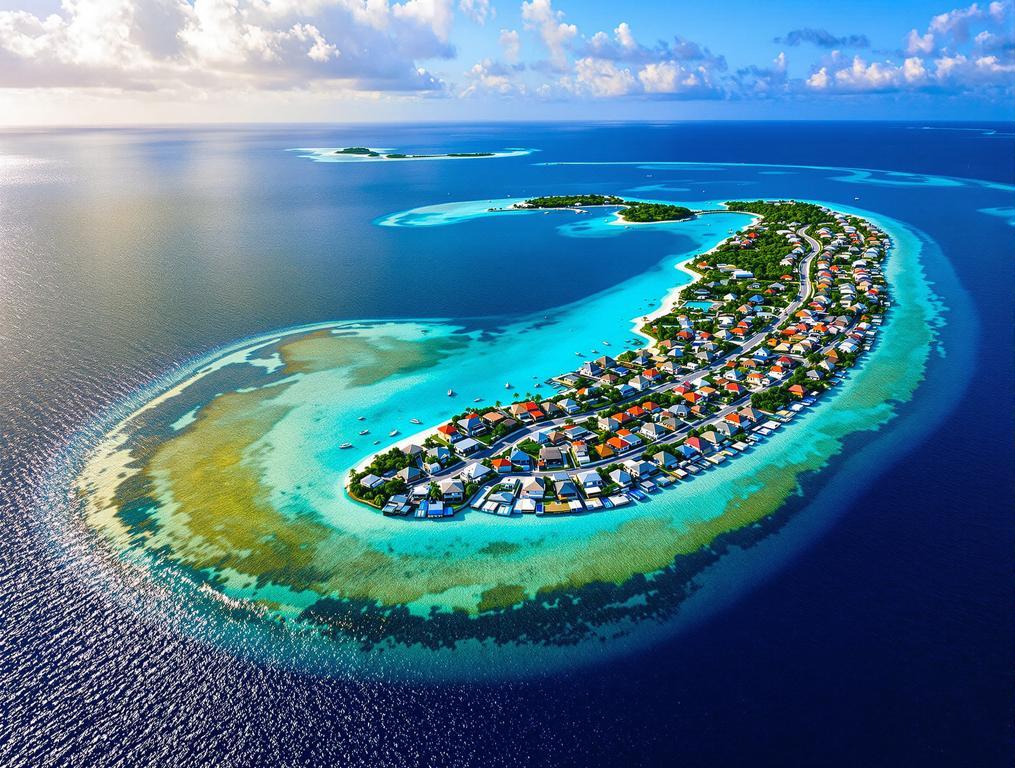I’m standing at the edge of a narrow strip of land where over 71,000 people live on a coral atoll just 3 meters above sea level. The morning buzz of South Tarawa, Kiribati’s capital, surrounds me as I navigate between tightly packed single-story homes. What’s striking isn’t just the crowds—it’s that this place packs Hong Kong-level population density into an area with no buildings taller than a coconut tree.
The statistics don’t prepare you for this reality. On paper, Tarawa is just another Pacific island. In person, it’s the world’s most surprising urban experiment—a megacity without skyscrapers, sprawling across a fragile coral ribbon between ocean and lagoon.
The World’s Secret Megacity: 71,000+ People on a 3-Meter High Coral Strip
South Tarawa crams 2,745 people per square kilometer into its narrow 26 square kilometers. That’s comparable to some of Hong Kong’s urban districts, yet without a single high-rise building in sight. Instead, traditional homes built from pandanus and coconut wood stand shoulder to shoulder.
“We’ve always lived with the sea as our boundary,” an elderly I-Kiribati woman tells me as we walk past a row of homes nearly touching the high tide mark. “But now the sea doesn’t respect those boundaries like before.”
This urban density paradox makes Tarawa unlike anywhere else on Earth. The settlement pattern evolved from traditional village structures called maneaba, community meeting places that remain the heart of I-Kiribati culture. Today, these traditional buildings stand alongside concrete government offices and tin-roofed homes.
Walking through Betio, Tarawa’s most densely populated islet with over 12,500 residents, the contrast becomes even more apparent. Unlike Alaska’s vertical solution to extreme environments, Tarawa spreads horizontally despite severe space limitations.
Hong Kong Density Meets Pacific Village Life: The Urban Paradox
The morning market in Bikenibeu village buzzes with activity as vendors arrange fresh fish, pandanus fruits, and handwoven mats. Despite its urban-level population density, daily life maintains rhythms more reminiscent of village existence than city living.
“We don’t think of ourselves as living in a crowded place. This is just home—we know everyone, share everything. It’s only when visitors come that we realize how unusual our situation is.”
Unlike luxury-focused Maldives atolls attracting wealthy tourists, Tarawa offers authentic Pacific urban life. Children play between tightly packed homes while women weave traditional mats under shade trees, creating an atmosphere where ancient traditions persist despite physical constraints.
This community-centered approach to density has created something economists and urban planners struggle to categorize—neither fully urban nor traditionally rural. Like small communities with outsized economic impact, Tarawa’s significance exceeds its geographical footprint.
WWII Relics and Traditional Dance: Where History Meets Living Culture
On Betio’s western shore, concrete Japanese bunkers from WWII sit partially submerged at high tide—silent reminders of the bloody 1943 battle that claimed over 6,000 lives in just 76 hours. These war relics stand in stark contrast to the vibrant cultural traditions practiced just meters away.
I time my visit perfectly for June’s dry season, when rainfall diminishes and cultural activities flourish. At the Kiribati National Museum, housed in a traditional maneaba, I watch young performers practice te bo dance, their movements telling stories passed through generations.
Communities worldwide are adapting to climate threats, similar to Barbuda’s post-hurricane rebuilding efforts, but Tarawa’s challenges run deeper. With maximum elevation of just 3 meters, rising seas threaten this entire urban ecosystem.
Visit Now: The Climate-Threatened Paradise (Dry Season Guide)
The best time to experience Tarawa is June through October during the dry season. Arrive via Bonriki International Airport on Fiji Airways’ twice-weekly flights from Nadi. Local transport consists primarily of minibuses costing about $1 AUD per ride.
For accommodations, Mary’s Motel in Bairiki offers clean rooms at $70 per night, while the more upscale Tarawa Boutique Hotel charges $120 with breakfast included. Book well ahead—limited rooms fill quickly during cultural festivals.
Climate adaptation in Tarawa differs from preservation challenges facing Alaska’s historic settlements. Here, the entire way of life stands at risk.
As my week in Tarawa ends, I can’t shake the feeling that I’ve witnessed something extraordinary—a community that’s mastered high-density living while maintaining cultural cohesion. My wife Sarah would call it “humanized urbanism” in her photographs. Walking along Bairiki’s shoreline as children return from school, their laughter carrying on the warm breeze, I realize Tarawa teaches us that a megacity’s true measure isn’t in its skyline, but in how its people weave their lives together—even as the waves inch closer each year.
